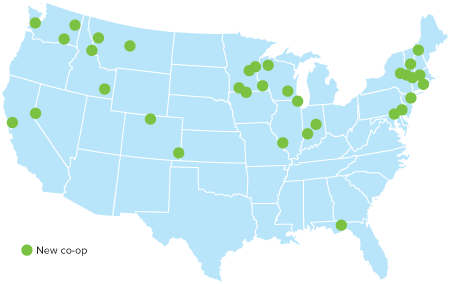The New Co-op Kids on the Block

When Food Co-op 500 was founded in late 2004, it took its name from Marilyn Scholl's challenge to the co-op community to build our sector to 500 storefronts within the next 10 years. The new wave of openings really started to kick in around 2006 and has continued at a steady pace.
How many retail food co-ops are there now? No one knows for sure! Cooperative Grocer has 335 listings in its directory, but some of those are in Canada or are not open yet, and co-ops with more than one storefront sometimes have only one listed. What we do know is that at least 36 new retail food co-ops started business in the last five years and over 250 more are in some stage of organizing. Many established co-ops have added additional storefronts, and a few have closed. So, while we have a moving target, I think it is reasonable to assume that there are between 325 and 350 retail food co-op storefronts in the U.S.
What have we learned about our newest co-ops? For starters, the cooperative principles may be the only thing they have in common. These stores range in annual sales from $30,000 to $12.5 million. Some serve small rural communities; others are struggling to make a difference in urban food deserts. There are new co-ops in New York City and Algona, Iowa. Altogether, 20 states have new food co-ops with the largest number (four) in New York. While most co-ops emphasize local and natural foods, some have a conventional grocery mix or even sell farm supplies. A couple of them are worker co-ops; most are consumer co-ops. About half the new co-ops have annual sales below $500,000 per year, while seven have sales that exceed $1 million.
The impact of these new co-ops is significant. Their combined sales volume is nearly $38 million. Over 400 employees (200 full-time equivalent) serve over 24,000 member-owners. Interestingly, nearly all of these co-ops have working-member programs that provide some portion of the operational labor, and a few require all members to provide a few hours of work per month. Only four of the largest co-ops use no member labor in their stores.
Numbers only tell part of the story. When I interviewed people at these co-ops, they were all excited about how the co-op was making a difference in their communities—even the smallest stores. Slowly but surely, people who had little exposure to healthier food options are learning why it matters. Farmers and producers are expanding their operations, and new ones are serving the market. Several growers have cited their local co-op as the major reason they have been able to stay in business.
Co-ops that have been open for as little as a year are already sharing their experiences and knowledge with other organizing groups. Perhaps the most telling comment I got came from a rural mountain community. When threatened with the closure of their only store, the citizens decided to make it truly their own. "If it had not been for this store, our community would have gone way downhill."
According to the Department of Commerce, 40 percent of all new businesses fail in the first year. After five years, a full 80 percent will have closed. Our new co-ops have been open from a few months to over five years—according to average figures, well over half should have failed by now. In fact, only four have closed. Of these, three were in inner-city, low-income communities and the fourth in a very small rural community.
These are perhaps the most difficult environments for new co-ops. They typically have limited investment capital, either due to income levels, low population, or both. Small rural communities may be able to find suitable locations at low cost, but their market areas are thinly populated and widely spread. Inner cities may bring some form of community investment, but suitable retail spaces are hard to find and generally expensive.
It is ironic that these are communities whose needs could best be served by cooperatives and their values. One of our great challenges as co-op developers is to find models that work in these communities, including structures, capital, and support.
Many of the other new co-ops are still struggling to find financial stability, but the loyalty of their members and resilience of the co-ops' staff and boards have kept them afloat. It is hardly surprising that this generation is still finding its way to success. Most start-up businesses, including co-ops, are lucky to break even before their third year. Couple that with a severe recession, and the very survival of this many stores is reason for celebration.







